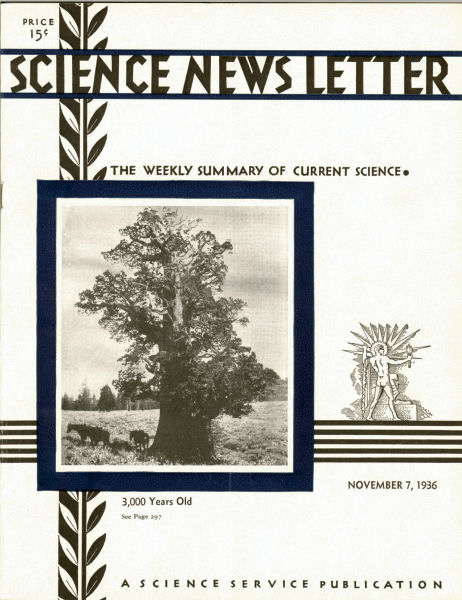From the November 7, 1936, issue

BIG TREES FIND AGE RIVAL IN SIERRA MOUNTAIN JUNIPER
California’s famous Big Trees, commonly rated as the oldest and largest living things, now have a rival, for age at least, in another California tree, a gnarled old juniper that grows in the High Sierra of Tuolumne County.
This veteran tree has been studied by Dr. Waldo S. Glock of the Carnegie Institution of Washington, who was guided to it by Clarence K. Bennett of Hillsborough. Dr. Glock took several samples of its wood with a core-cutting borer, and carefully counted the annual rings. He figures a conservative age for the tree at 3,000 years. This compares closely with the greatest age known for a Big Tree, 3,250 years.
The Bennett Juniper grows in a windswept place at an elevation of about 8,500 feet. The combination of exposure and the natural slow rate of growth of junipers have kept it from attaining anything near the size of the Big Trees. It is only about 80 feet high, but its trunk measurements are impressive: 21 feet, 6 inches, at the ground, with an average diameter of 14 feet, 2 inches, 5 feet above the ground.
The slowness of its growth shows up strikingly in Dr. Glock’s borer cores. During the past 700 years, the tree has added only 2 feet to its diameter.
VACCINE FOR INFLUENZA IS NOW READY FOR TRIAL USE
A vaccine that promises protection against influenza is at hand, it appears from the report of Dr. Thomas Francis Jr. of the Rockefeller Institute to the American Public Health Association.
A group of human volunteers has been vaccinated with human influenza virus vaccine. The vaccinations “took” so far as laboratory tests show. The blood of the vaccinated persons injected into mice kept these animals from getting the disease when flu virus was given them. The tests showed that the vaccinated persons had developed a supply of flu-fighting antibodies in their blood. The big question is whether these flu fighters will protect a vaccinated person against the disease when an influenza epidemic comes along to give him a big dose of the virus that causes influenza. Another point to be settled is how long the flu-fighting antibodies will remain in the blood.
OZONE CLOSER TO EARTH OVER THE POLAR REGIONS
The stratosphere’s ozone layer is closer to Earth in the polar regions than over the equatorial portion of the Earth, Dr. E. Regener of Stuttgart, Germany, concludes (Nature, Sept. 26).
Dr. Regener, who is famous for his cosmic-ray studies, sent up sounding balloons, which took samples of the air at heights up to 18 miles and brought them back to Earth. At this height, there is a deficit of 2 to 3 percent of the air’s oxygen content. Above 12 miles, there is considerable variation in oxygen content of different samples. Dr. Regener attributes this to the weather conditions.
The lower ozone layer at the poles is probable, Dr. Regener said, because of the decrease in oxygen content at lower heights over the poles than at the equator and because the greater stability of the atmosphere in the polar regions tends to increase the diffusion of the heavy ozone downward.
Ozone in the atmosphere acts as barrier to some of the most actinic of the visible and invisible rays of the sun.







